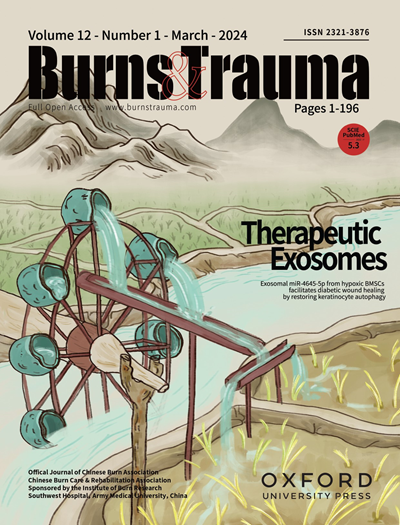人尿源性干细胞在体外和隐性营养不良大疱性表皮松解症小鼠模型中拯救皮肤表现并抑制炎症和纤维化
IF 9.6
1区 医学
Q1 DERMATOLOGY
引用次数: 0
摘要
隐性营养不良大疱性表皮松解症(RDEB)是一种危及生命的疾病,其特征是持续的伤口炎症、组织纤维化,甚至在后期发生肿瘤。尽管RDEB对全世界患者的健康产生重大影响,但其治疗选择有限。现在显然需要进行干预。本研究的目的是探讨尿源性干细胞(USCs)在RDEB中的潜在功效。方法我们从健康供体中分离出人USCs,并在体外三维共培养系统中与组织工程皮肤和体内与COL7A1−/−(RDEB)小鼠一起评估其对RDEB的治疗效果。结果USCs对RDEB相关炎症和纤维化基因的表达均有抑制作用。经肝内给药后,USCs还能延长RDEB小鼠的中位寿命(3 ~ 5天),提高C7的表达,并向各器官迁移。综上所述,这些结果提示USCs在改善RDEB的C7表达和修复RDEB的潜在作用,支持USCs在未来治疗RDEB患者中的应用。本文章由计算机程序翻译,如有差异,请以英文原文为准。
Human Urine-Derived Stem Cells Rescue Cutaneous Manifestation and Suppress Inflammation and Fibrosis In Vitro and in a Mouse Model of Recessive Dystrophic Epidermolysis Bullosa
Background Recessive dystrophic epidermolysis bullosa (RDEB) is a life-threatening disease characterized with persistent wound inflammation, tissue fibrosis, and even tumorigenesis in later stages. Despite its significant impact on patient health worldwide, treatment of RDEB has limited options. There in a clear need for now interventions. The goal of this study was to explore the potential efficacy of urine-derived stem cells (USCs) in RDEB. Methods We isolated human USCs from healthy donors, and assessed their therapeutic effects on RDEB both in vitro with tissue engineered skin in a three-dimensional co-culture system and in vivo with COL7A1−/− (RDEB) mice. Results USCs showed suppressive effects on expression of inflammation- and fibrosis- related genes involved in RDEB in vitro and in vivo. USCs could also extend the median life span (from 3 to 5 days), improve the expression of C7, and migrate to various organs of RDEB mice after intrahepatic administration. Conclusions In summary, these results suggest the potential effects of USCs on improving the the expression of C7 and would repair of RDEB, which supported the future use of USCs for the treatment of RDEB patients.
求助全文
通过发布文献求助,成功后即可免费获取论文全文。
去求助
来源期刊

Burns & Trauma
医学-皮肤病学
CiteScore
8.40
自引率
9.40%
发文量
186
审稿时长
6 weeks
期刊介绍:
The first open access journal in the field of burns and trauma injury in the Asia-Pacific region, Burns & Trauma publishes the latest developments in basic, clinical and translational research in the field. With a special focus on prevention, clinical treatment and basic research, the journal welcomes submissions in various aspects of biomaterials, tissue engineering, stem cells, critical care, immunobiology, skin transplantation, and the prevention and regeneration of burns and trauma injuries. With an expert Editorial Board and a team of dedicated scientific editors, the journal enjoys a large readership and is supported by Southwest Hospital, which covers authors'' article processing charges.
 求助内容:
求助内容: 应助结果提醒方式:
应助结果提醒方式:


